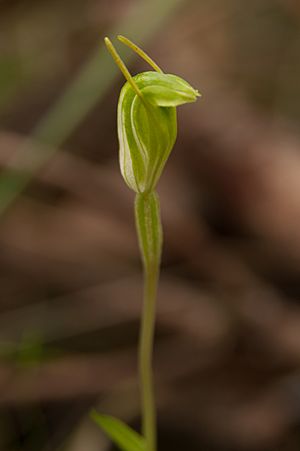Tall snail orchid facts for kids
Quick facts for kids Tall snail orchid |
|
|---|---|
 |
|
| Scientific classification | |
| Genus: |
Pterostylis
|
| Species: |
pyramidalis
|
| Synonyms | |
|
|
The Pterostylis pyramidalis, also called the tall snail orchid or leafy snail orchid, is a special type of orchid. It only grows in the south-west part of Western Australia. This means it is endemic to that area. You can often tell it apart from other snail orchids because it can grow quite tall, up to 35 cm (10 in).
Contents
What the Tall Snail Orchid Looks Like
The tall snail orchid has several leaves. Some leaves grow close to the bottom of the plant. These usually have a small stalk, called a petiole. Other leaves are found higher up on the flower stem. These leaves do not have a stalk; they are sessile.
Leaves and Stem Details
The leaves are about 8–23 mm (0.3–0.9 in) long. They are also about 8–12 mm (0.3–0.5 in) wide. The main flower stem is smooth and can grow from 10–35 cm (4–10 in) tall.
Flowers and When They Bloom
The flowers of the tall snail orchid are green and white. They are about 16 mm–20 mm × 6 mm–8 mm (0.6 in–0.8 in × 0.2 in–0.3 in) in size. You can see these flowers from August to October. Interestingly, summer fires can help these orchids to bloom.
How the Tall Snail Orchid Got Its Name
The scientific name Pterostylis pyramidalis was first officially written down in 1840. This was done by a person named John Lindley. He wrote about it in a book called A Sketch of the Vegetation of the Swan River Colony.
Understanding the Name
The second part of the name, pyramidalis, comes from a Latin word. It means "pyramid-shaped". This describes the shape of some part of the plant. Some scientists have suggested a different name, Linguella pyramidalis. However, this new name is not widely used, even by the Western Australian Herbarium.
Where the Tall Snail Orchid Lives
The tall snail orchid likes to grow in wet areas. It is often found on the edges of swamps. It prefers grey-black peaty sand. Sometimes, many of these orchids grow together, forming large groups. Their flowers can even be partly underwater.
Regions Where It Grows
This orchid is found in several natural areas of Western Australia. These include the Avon Wheatbelt, Esperance Plains, Jarrah Forest, Mallee, Swan Coastal Plain, and Warren regions.
Protecting the Tall Snail Orchid
The Government of Western Australia's Department of Parks and Wildlife has looked at this orchid. They have classified it as "not threatened". This means it is not currently at risk of disappearing.

